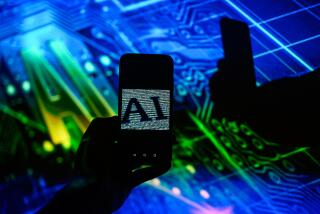BOOK REVIEW : ‘The Turing Option’: Novel Owes More to Science Than to Art : THE TURING OPTION, <i> by Harry Harrison and Marvin Minsky,</i> Warner Books, $21.95; 422 pages
- Share via
In Tokyo, the “Real-World” computing project is seeking to mimic the behavior of the human brain. Meanwhile, in Cambridge, Mass., a rat-sized creature with a segmented body and more legs than any living vertebrate moves like an enormous insect across an obstacle course. A robot built by researchers at MIT using evolutionary models, it is learning to cope with its laboratory environment.
Scientists involved in these projects are seeking to understand the human brain through artificial intelligence, or AI. Although computers can already calculate enormous numbers and play champion-level checkers, no computer yet built can banter, read facial expressions or analyze character in a business deal.
It may be just a matter of time, however, before machine descendants of MIT’s robots will be able to chat and make ethical decisions. Should this time arrive, would we have created a species, thus beginning a new stage of evolution?
The question is one of many explored in “The Turing Option,” a novel by veteran science-fiction writer Harry Harrison and Marvin Minsky, the former director of MIT’s AI laboratory.
Alan Turing, the British genius referred to in the title, described the human brain as a computer as early as 1937. By 1950, observing the rapid development of the new science, Turing prophesied that by the end of the century, “educated opinion will have altered so much that one will be able to speak of machines thinking without expecting to be contradicted.”
Finding the end of the century a bit too soon for the realization of Turing’s prophecy, the authors set their tale in 2023, a time in which AI researchers work alongside brain surgeons.
The story opens in the Southern California desert headquarters of Megalobe Industries, a site filled with the predictable hardware of futuristic science fiction. Brian, a 23-year-old prodigy who had been working on AI, has had a good part of his skull blasted away by corporate raiders (in the next century raiders use guns). His life is saved by his collaborator, a neurosurgeon.
Given that the brain will have been almost completely mapped by this time, it is simply a matter of diligence and concentration for the neurosurgeon to reconnect the vast numbers of disrupted neural connections. Where the damage is total, she inserts PNEP chips, programmable neural electron pathway devices. “It was like combining surgery with solving a jigsaw puzzle, since every one of those PNEPs had a different shape in order to perfectly contact the surface of the brain.”
An interface between human and machine intelligence, the chips are coated with living embryonic human nerve cells. Although one might expect such a procedure to be controversial, the authors posit a new Pope who has blessed population control (including abortion) and allowed this kind of medical research.
The surgery is successful. Brian recovers control of his body and what memory the bullet didn’t destroy--his whole life until his 14th year. Not to worry. He still has his remarkable IQ. All he has to do to outwit his would-be killers is to rethink the research he had been doing before he was attacked.
The authors take us into Brian’s mind to demonstrate the sensation of synapses suddenly connecting, some lost memories returning and the conundrum of being an adult with the mind, but not the hormones, of an adolescent. This is a hard literary task at which the authors are only partly successful.
Their born-again hero gets a second chance to argue with his pious stepmother, who insists: “We have God-given souls, and he is not giving them out to machines!” This enables Brian to respond: “My work has given me some insight into the brain and what might be called the human condition. . . . Can machines have souls? You ask me that and I ask you if souls can learn.”
The fast-moving plot almost compensates for the flat characterization and pedestrian style. “The Turing Option” scarcely merits discussion as literature, but it is worth contemplating because we know that Minsky understands what is technologically possible and has mulled over the implications.
Unfortunately, the novel’s focus is limited to the development of one man and his machine, although by its conclusion there are already several robots, each with a memory and unique personality. I am troubled by the ramifications of all these robots interacting with an army of post-operative Brians walking around with PNEP implants to enhance their powers. The interplay of these folks would surely provoke some mind-boggling situations. Perhaps that will be the story of “The Turing Option, II.”
More to Read
Sign up for our Book Club newsletter
Get the latest news, events and more from the Los Angeles Times Book Club, and help us get L.A. reading and talking.
You may occasionally receive promotional content from the Los Angeles Times.









